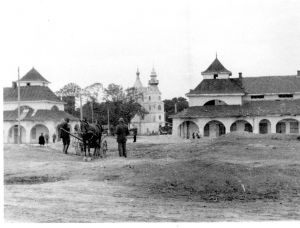Tomaszow Lubelski

Tomaszow Lubelski - June 1941
Tomaszow Lubelski is a town in South-east Poland. During the interwar years, some 5,600 Jews lived in Tomaszow Lubelski, more than half the town’s population. Most were merchants and artisans who worked mainly in the clothing industry and at a foundry. The Jewish community had mutual-assistance trade associations, charitable and welfare societies supported by organisations and Jewish communities out of town, a free –loan fund, and a savings- and-loan association. Tomaszow Lubelski was an important Hasidic centre and the seat of rebbes of various courts. Zionist parties and pioneering movements were active there, as were Agudath Israel and the Bund. A Jewish weekly was published in Tomaszow Lubelski, and there were several Jewish cultural associations.
The Germans occupied the town on 13 September 1939 and immediately begun abducting Jews for forced labour. Six Jews were murdered. On 20 September 1939, the Germans withdrew and the Soviets entered the town. A week later the Soviets pulled back to the demarcation line established in the Molotov – Ribbentrop Pact. They were joined by some 2,000 local Jews, including the Hasidic rebbe Aryeh Leibush Rubin. Some 3,500 Jews remained in Tomaszow Lubelski. When the Germans returned, the persecutions resumed. Several Jews were murdered in December 1939 and at the end of that month the Jews were required to affix a yellow badge to their clothing and wear a Star-of –David armband. Shortly after the occupation began, the Germans appointed a Judenrat and installed Yehoshua Fishelson at its head. The Judenrat was ordered to mobilise Jews aged twelve to fifty for forced labour and to pay large ransoms and it opened a soup kitchen. Eventually, two streets in the town became an open ghetto and in the spring of 1942 the Gestapo executed Fishelon and his family for refusing to provide the Germans with a list of Jews to be deported.
In March 1942 the Germans deported all Jews aged thirty-two and over to the newly established Belzec death camp. Another transport set out on 22 May 1942 and on 27 October 1942, the Gestapo deported the remaining Jews in the open ghetto to the Belzec extermination camp.
Sources:
The Yad Vashem Encylopiedia of the Ghettos During the Holocaust Volume 1 – published by Yad Vashem, 2009.The Holocaust – The Jewish Tragedy, by Martin Gilbert, published by Collins London 1986
Photograph – Chris Webb Archive
© Holocaust Historical Society 2014

